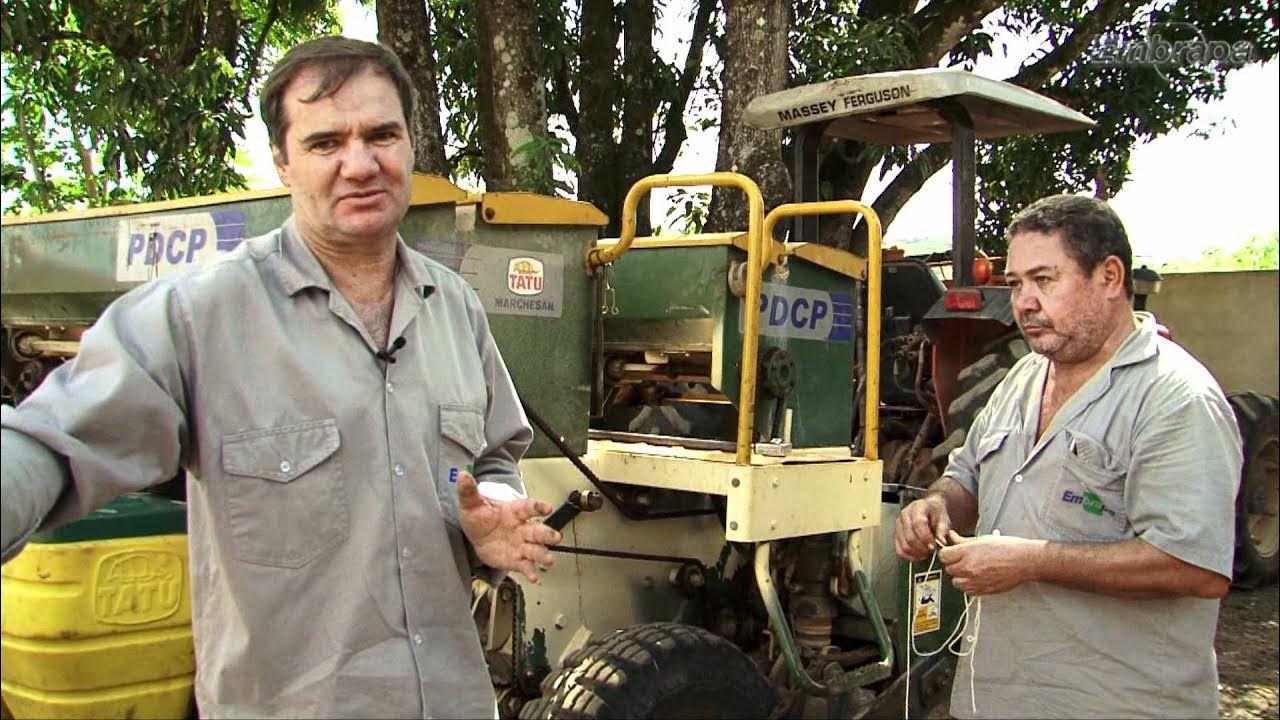Mecanização Agrícola - Parte IV
Summary
TLDRThis video demonstrates the process of calibrating a planting machine to ensure optimal seed distribution and soil management. Key steps include checking seed distribution by digging in different spots, adjusting seed depth to 3-5 cm, and ensuring the tractor speed does not exceed 6 km/h to prevent seed damage. The video also covers the machine's components, such as the cutting, fertilizer, and seed distribution disks. Proper machine calibration is essential for efficient planting and better crop productivity, ensuring consistent emergence and growth for a successful harvest.
Takeaways
- 😀 Seed distribution is critical for a uniform planting pattern. Checking seed placement ensures that the desired number of seeds per meter is accurate.
- 😀 Seed depth should be between 3 to 5 cm for optimal germination and growth. Shallow or deep planting can harm plant development.
- 😀 Consistent seed depth is necessary to prevent uneven emergence and ensure uniform plant growth, leading to better crop yield.
- 😀 Tractor speed should not exceed 6 km/h when planting to avoid damaging the seeds, which can result in inconsistent seed placement.
- 😀 The cutting disc, located at the front of the machine, cuts through the straw and prepares the soil for the following planting elements.
- 😀 The fertilizer distributor disc ensures that fertilizer is placed correctly for optimal crop nutrition and growth.
- 😀 Seed distribution discs are responsible for placing seeds at the correct depth and spacing for uniform growth.
- 😀 Proper machine calibration is key to ensuring the machine's components function together efficiently, improving planting results.
- 😀 Depth control wheels can be adjusted to regulate seed planting depth, affecting the success of seed germination.
- 😀 Checking and adjusting the machine's components, such as the cutting disc and leveling mechanisms, ensure accurate planting and a smooth operation.
- 😀 A well-calibrated planting machine improves crop productivity by ensuring consistent seed spacing and distribution across the field.
Q & A
What is the primary purpose of checking the seed distribution in the field?
-The primary purpose is to ensure that the correct quantity of seeds is being distributed evenly along the planting line, as specified during the setup process.
How is the seed distribution checked in the field?
-Seed distribution is checked by digging small holes along the planting line at different spots, around 2-3 meters apart, to observe the number of seeds placed in those areas.
What was the outcome of checking the seed distribution?
-The seed distribution was confirmed to be perfect, with approximately five seeds falling within a meter, as planned during the setup.
Why is the depth of seed placement important?
-The depth of seed placement is critical for ensuring uniform emergence. If seeds are too deep or too shallow, they may struggle to germinate or emerge at different times, leading to inconsistent plant growth.
What is the ideal depth for planting corn seeds?
-The ideal depth for planting corn seeds is between 3 to 5 cm, as this range ensures proper seed germination and uniform plant emergence.
What happens if the corn seeds are planted too deep or too shallow?
-If planted too deep, seeds may fail to emerge properly, while if they are too shallow, they might not develop correctly, affecting the plant's growth and productivity.
How is the seed planting depth controlled on the machine?
-The depth is controlled by adjusting two screws and depth control wheels on the machine. The height of the wheels determines whether the seed is planted deeper or shallower.
Why is tractor speed important during planting?
-The tractor speed is important because if it exceeds 6 km/h, the seeds may break or get damaged, leading to an inconsistent plant population, which can affect the final yield.
What are the key components of the planting line on the machine?
-The key components include the cutting disc (used to cut through residue), the fertilizer distributor disc (behind the cutting disc), and the seed distribution disc (at the rear), all working together for proper seed and fertilizer placement.
What is the role of the leveling component (tirante) on the machine?
-The leveling component, or tirante, helps to balance and level the machine during planting. It ensures the machine remains stable and works evenly across the field.
How does the pressure adjustment on the cutting disc affect the planting process?
-The pressure adjustment on the cutting disc allows for more or less pressure to be applied to the disc, affecting how well it cuts through the residue. This is crucial for ensuring that the other components can function properly.
What is the expected outcome when all machine settings are correctly adjusted?
-When all machine settings are properly adjusted, it leads to an even plant distribution, which enhances productivity and ensures a higher crop yield.
Outlines

Cette section est réservée aux utilisateurs payants. Améliorez votre compte pour accéder à cette section.
Améliorer maintenantMindmap

Cette section est réservée aux utilisateurs payants. Améliorez votre compte pour accéder à cette section.
Améliorer maintenantKeywords

Cette section est réservée aux utilisateurs payants. Améliorez votre compte pour accéder à cette section.
Améliorer maintenantHighlights

Cette section est réservée aux utilisateurs payants. Améliorez votre compte pour accéder à cette section.
Améliorer maintenantTranscripts

Cette section est réservée aux utilisateurs payants. Améliorez votre compte pour accéder à cette section.
Améliorer maintenant5.0 / 5 (0 votes)






